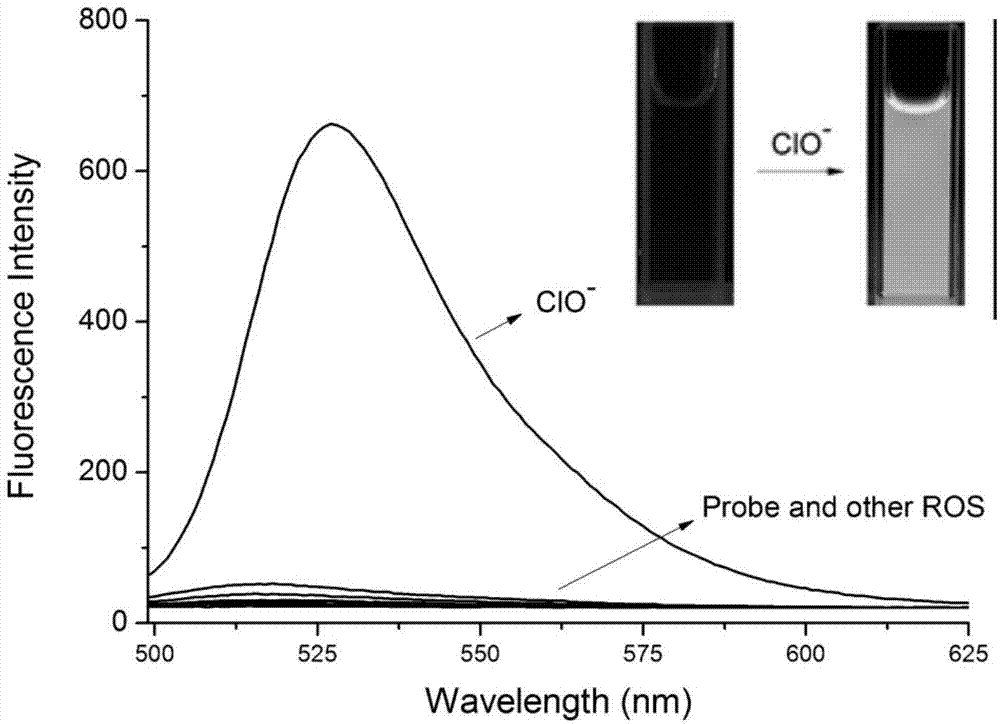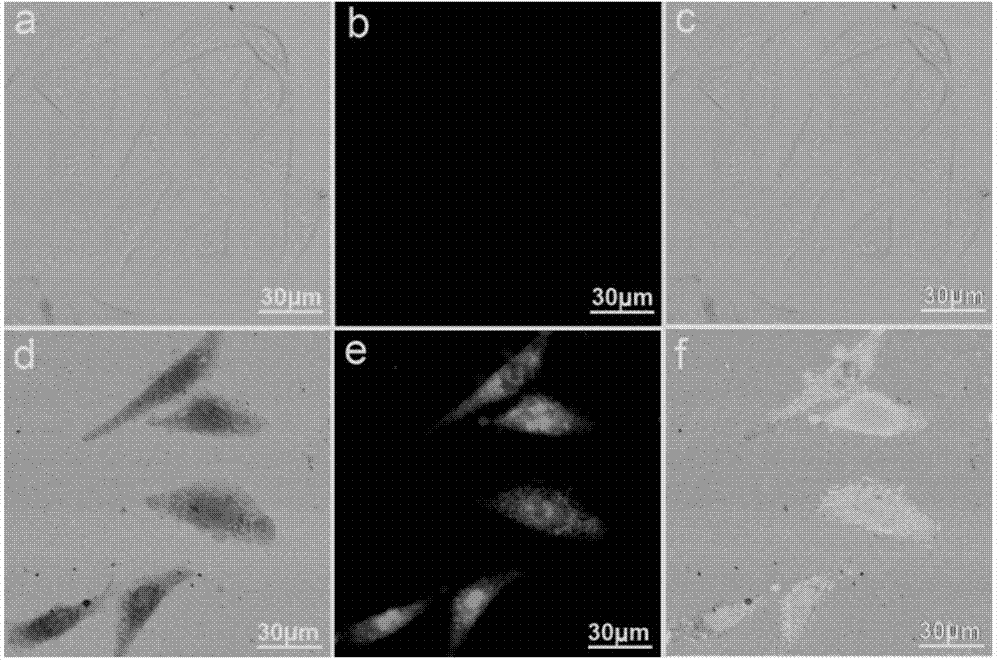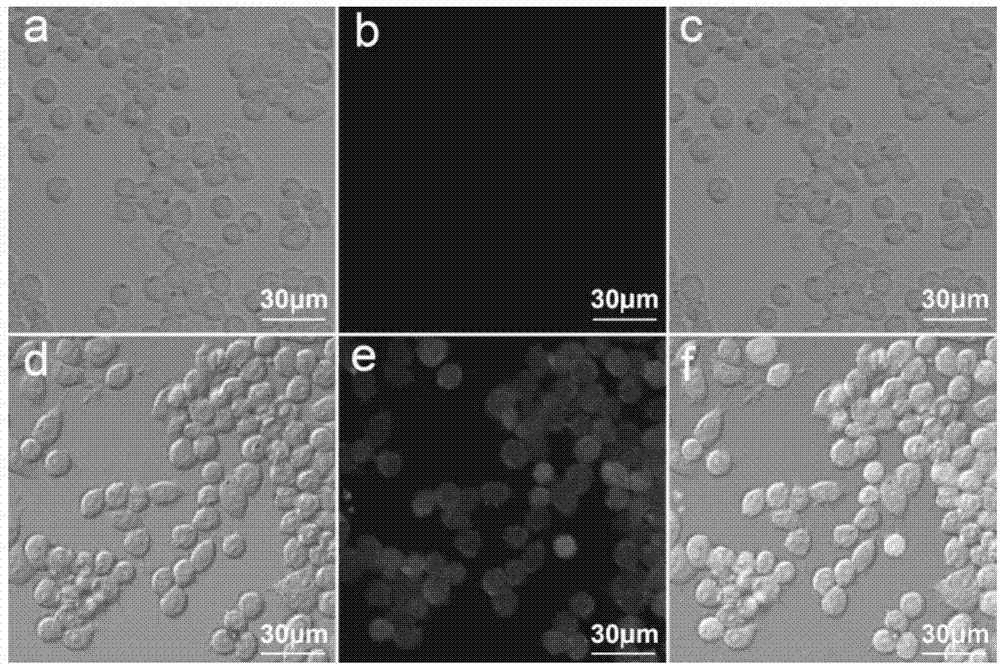Hypochlorite ion fluorescence probe, preparation method and application thereof
A technology of hypochlorite and fluorescent probes, applied in the direction of fluorescence/phosphorescence, chemical instruments and methods, luminescent materials, etc., can solve the problems of low sensitivity, poor water solubility of probes, poor cell membrane permeability, etc., and achieve good selectivity and The effect of specificity, simple and easy preparation process, and easy large-scale production
- Summary
- Abstract
- Description
- Claims
- Application Information
AI Technical Summary
Problems solved by technology
Method used
Image
Examples
Embodiment 1
[0031] Embodiment 1 prepares hypochlorite fluorescent probe
[0032] 1. Preparation of fluorescein monoaldehyde
[0033] Put 4g of fluorescein, 10mL of chloroform, 6mL of methanol, and 0.06g of 15-crown-5 into the flask for reaction, then add 20g of 50% sodium hydroxide solution, stir at 55°C for 5 hours, and after cooling, use a concentration of 10mol / Acidify with L sulfuric acid to produce a precipitate, filter, collect the precipitate, dry in vacuo, and separate the product by silica gel chromatography, using dichloromethane / methanol (200:3) as the eluent to obtain a light yellow fluorescein monoaldehyde solid.
[0034] 2. Preparation of probes
[0035] Within 30 min, slowly dropwise add 5 mL of methanol solution in which 59 mg of hydrazinopyridine was dissolved in 200 mg of fluorescein monoaldehyde in 40 mL of ethanol. The reaction was carried out at room temperature for 12 hours, and the product was precipitated out after the reaction was completed. The product was co...
Embodiment 2
[0038] Spectral properties of hypochlorite fluorescent probes reacted with various reactive oxygen species prepared in embodiment 2
[0039] Weigh 4.5 mg of the hypochlorite fluorescent probe prepared in Example 1, and prepare a 10 mL acetonitrile solution with a concentration of 1 mM as the mother solution.
[0040] Fluorescence spectrum test: 30 μL of the above mother solution was added to a certain amount of 10 mM PBS buffer solution (pH 7.4), and then various ionic reactive oxygen species (ROS) were added respectively. (H 2 o 2 :200μM; NO · : 200 μM NOC-12; · o 2 - :0.1unit xanthine oxidase and 200μM xanthine; ONOOˉ:1mM KNO 2 +1mM H 2 o 2 ;ROO · : 200μM 2,2-azobis(2-methylpropylimidium) dihydrochloride; 1 o 2 : 1mM ammonium ferrous sulfate+1mM tert-butyl hydroperoxide; · OH: 1mM ammonium ferrous sulfate + 200μM H 2 o 2 ; NaClO: 100 μM) The final concentration of the fluorescent probe was 10 μM. The fluorescence emission spectrum was tested immediately under ...
Embodiment 3
[0044] Spectral properties of hypochlorite fluorescent probe and hypochlorite reaction product prepared in embodiment 3
[0045] Add 30 μL of the mother solution in Example 2 to a certain amount of 10 mM PBS buffer solution (pH 7.4), and then add different equivalents of sodium hypochlorite solution, so that the final concentration of the fluorescent probe is 10 μM, and the final concentration of hypochlorite ions is 0 μM respectively , 5 μM, 10 μM, 20 μM, 30 μM, 40 μM, 50 μM. Immediately after the addition of ions, their fluorescence emission spectra were measured. The fluorescence emission spectrum is excited at 494nm; the slit width of excitation and emission is 1.5 / 1.5nm. The resulting fluorescence increment graph is shown in figure 2 .
[0046] The experimental results show that the fluorescence intensity after the reaction increases with the concentration of sodium hypochlorite; the fluorescence intensity after the reaction has a linear relationship with the concentr...
PUM
 Login to View More
Login to View More Abstract
Description
Claims
Application Information
 Login to View More
Login to View More - R&D
- Intellectual Property
- Life Sciences
- Materials
- Tech Scout
- Unparalleled Data Quality
- Higher Quality Content
- 60% Fewer Hallucinations
Browse by: Latest US Patents, China's latest patents, Technical Efficacy Thesaurus, Application Domain, Technology Topic, Popular Technical Reports.
© 2025 PatSnap. All rights reserved.Legal|Privacy policy|Modern Slavery Act Transparency Statement|Sitemap|About US| Contact US: help@patsnap.com



